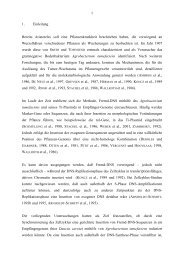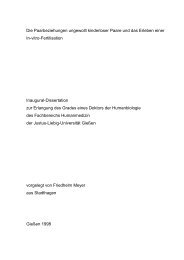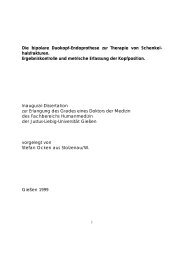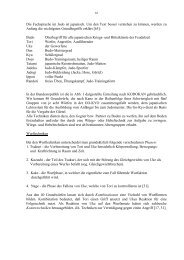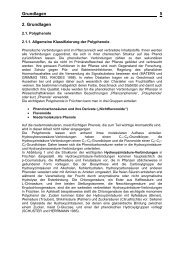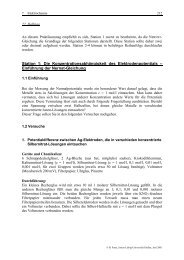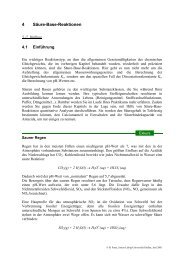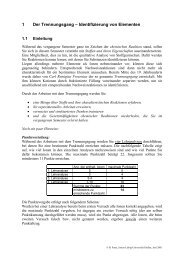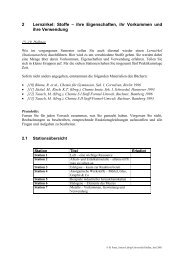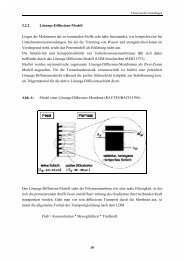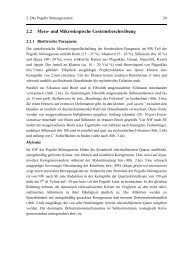Effects of diabaticity on fusion of heavy nuclei in the dinuclear model ...
Effects of diabaticity on fusion of heavy nuclei in the dinuclear model ...
Effects of diabaticity on fusion of heavy nuclei in the dinuclear model ...
You also want an ePaper? Increase the reach of your titles
YUMPU automatically turns print PDFs into web optimized ePapers that Google loves.
to <strong>the</strong> DNS c<strong>on</strong>cept [18, 34], cross secti<strong>on</strong>s for <strong>the</strong> syn<strong>the</strong>sis <str<strong>on</strong>g>of</str<strong>on</strong>g> <strong>the</strong> heaviest elements <strong>in</strong> nearly<br />
symmetric reacti<strong>on</strong>s are very small due to large fusi<strong>on</strong> barriers <strong>in</strong> mass asymmetry and, corre-<br />
sp<strong>on</strong>d<strong>in</strong>gly, due to small fusi<strong>on</strong> probabilities, for example <strong>in</strong> <strong>the</strong> reacti<strong>on</strong>s 128 Sn+ 126 Sn→254 Fm<br />
and 132 Sn+ 132 Sn→264 Fm.<br />
4-1shows <strong>the</strong> fusi<strong>on</strong> barriers B Table TCSM<br />
η<br />
<strong>in</strong> η calculated with <strong>the</strong> TCSM-method for <strong>the</strong><br />
reacti<strong>on</strong>s which produce <strong>the</strong> systems <str<strong>on</strong>g>of</str<strong>on</strong>g> <strong>the</strong> Figs. 4-1to 4-5. These barriers are compared with<br />
<strong>the</strong> experimental surplus <str<strong>on</strong>g>of</str<strong>on</strong>g> energy ∆B exp = B exp −<br />
above <strong>the</strong> Bass barrier BBass [76].<br />
BBass<br />
value <str<strong>on</strong>g>of</str<strong>on</strong>g> B The exp def<strong>in</strong>ed [4] as <strong>the</strong> value <str<strong>on</strong>g>of</str<strong>on</strong>g> <strong>the</strong> bombard<strong>in</strong>g energy for a fusi<strong>on</strong> probability<br />
is<br />
0.5. The Bass potential [77] is an empirical nucleus-nucleus potential derived from a geometric<br />
<strong>in</strong>terpretati<strong>on</strong> <str<strong>on</strong>g>of</str<strong>on</strong>g> fusi<strong>on</strong> data above <strong>the</strong> Coulomb barrier for systems with Z 1 ×<br />
2 =64−850. Z<br />
shown <strong>in</strong> Table 4-1, <strong>the</strong> isotopic trends <str<strong>on</strong>g>of</str<strong>on</strong>g> <strong>the</strong> fusi<strong>on</strong> barrier, calculated with <strong>the</strong> TCSM-<br />
As<br />
method, agree with <strong>the</strong> experimental data. The experimentally observed h<strong>in</strong>drance <str<strong>on</strong>g>of</str<strong>on</strong>g> <strong>the</strong><br />
fusi<strong>on</strong> roughly <strong>in</strong>creases with a grow<strong>in</strong>g Coulomb repulsi<strong>on</strong> between <strong>the</strong> collid<strong>in</strong>g <strong>nuclei</strong>, but<br />
also <strong>the</strong>ir shell structure and isotopic compositi<strong>on</strong> play a major role [78, 79, 80]. The energy<br />
thresholds for fusi<strong>on</strong> <strong>in</strong>crease and, corresp<strong>on</strong>d<strong>in</strong>gly, <strong>the</strong> fusi<strong>on</strong> probabilities decrease [79, 80]<br />
when <strong>the</strong> neutr<strong>on</strong> number <str<strong>on</strong>g>of</str<strong>on</strong>g> projectile or target <strong>in</strong>creas<strong>in</strong>gly deviates from a magic number <strong>in</strong><br />
<strong>the</strong> reacti<strong>on</strong>s 90,96 Zr + 90,96 Zr, 90,96 Zr + 100 Mo, 94,100 Mo+ 100 Mo and 90,96 Zr + 124 Sn. This<br />
effect is simply expla<strong>in</strong>ed by <strong>the</strong> deformati<strong>on</strong> <str<strong>on</strong>g>of</str<strong>on</strong>g> <strong>the</strong> <strong>nuclei</strong> <strong>in</strong> <strong>the</strong> <strong>in</strong>itial DNS and <strong>in</strong> <strong>the</strong> DNS at<br />
<strong>the</strong> top <str<strong>on</strong>g>of</str<strong>on</strong>g> <strong>the</strong> barrier <strong>in</strong> η and by <strong>the</strong> shell effects <strong>in</strong> dependence <str<strong>on</strong>g>of</str<strong>on</strong>g> <strong>the</strong> DNS potential energy <strong>on</strong><br />
η [34, 67]. In <strong>the</strong>se calculati<strong>on</strong>s, we did not average <strong>the</strong> <strong>in</strong>ner fusi<strong>on</strong> barrier <strong>in</strong> mass asymmetry<br />
over all possible orientati<strong>on</strong>s <str<strong>on</strong>g>of</str<strong>on</strong>g> collid<strong>in</strong>g <strong>nuclei</strong> as we usually do <strong>in</strong> <strong>the</strong> calculati<strong>on</strong>s <str<strong>on</strong>g>of</str<strong>on</strong>g> fusi<strong>on</strong> and<br />
evaporati<strong>on</strong> residue cross secti<strong>on</strong>s, tak<strong>in</strong>g <strong>the</strong> half <str<strong>on</strong>g>of</str<strong>on</strong>g> <strong>the</strong> deformati<strong>on</strong> parameters <str<strong>on</strong>g>of</str<strong>on</strong>g> <strong>the</strong> <strong>nuclei</strong><br />
<strong>in</strong> <strong>the</strong> entrance channel. They are not always <strong>in</strong> good agreement with ∆B exp because <strong>the</strong>se<br />
data are not directly measurable but are obta<strong>in</strong>ed with <strong>model</strong> assumpti<strong>on</strong>s about <strong>the</strong> fusi<strong>on</strong>,<br />
<strong>the</strong> surviv<strong>in</strong>g probabilities and <strong>the</strong> Bass barrier.<br />
46



